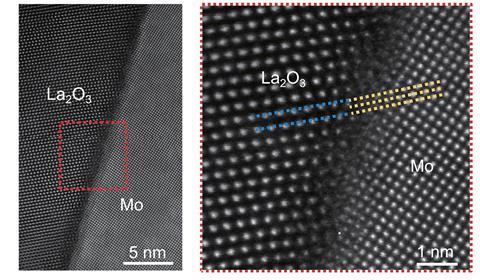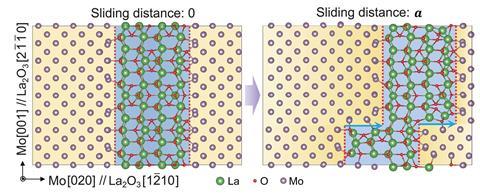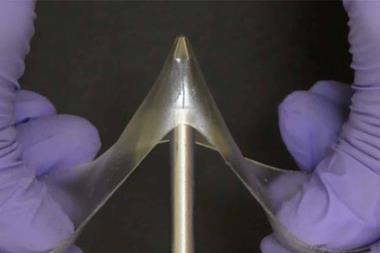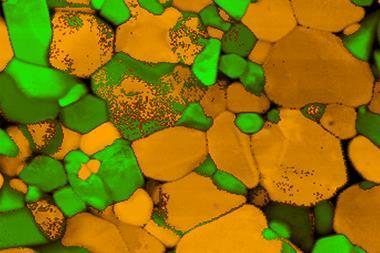A new technique allows ceramics to become more ductile without losing their strength. It involves the controlled growth of a metal layer on the ceramic surface, which allows its structure to rearrange under stress rather than failing. The researchers behind the work suggest that the method could allow ceramics to be used in biomedical and aerospace applications for which they are currently ill-suited.

The extreme strength and rigidity of chemical bonds in ceramics makes them useful for applications like drill bits and high-temperature insulation. This is a double-edged sword, however, as when the bonds do eventually give way the structure tends to fail catastrophically. In metals, by contrast, the atoms can slip past each other and bond to new atoms more easily, allowing the materials to bend rather than break. A long-standing goal of materials scientists is to combine the deformation resistance, or strength, of ceramics with the energy absorption, or toughness, of metals.
In 2022, Kexin Chen at Tsinghua University in Beijing and colleagues toughened silicon nitride by sintering it into dual-phase grains. When compressed, these grains dissipated energy by changing to the high-pressure phase. But tensile stress is trickier to manage because when a crack is introduced, the stress concentrates at the crack tip and acts to pull the lattice apart.
In the new work, Chen and her colleagues combined the properties of ceramics and metals by literally combining the two materials. The researchers used mixed aqueous precursors of lanthanum oxide and molybdenum in solution before drying and sintering the resulting gel. The material comprised strongly bonded, lattice-matched layers of metal and ceramic.
The material’s resistance to elastic deformation was at least as high as that of conventional lanthanum oxide. At the point at which lathanum oxide fractured catastropically, however, their material simply extended slightly, releasing stress that had built up in the structure. Models suggested that dislocations had nucleated in the metal lattice and slipped into the lanthanum, endowing the combined material with the strength of the ceramic and the toughness of the metal. The researchers also tested the process using cerium oxide in place of lanthanum oxide, finding similar results.
Materials scientist Nitin Padture from Brown University in Rhode Island, US says the work is a ‘clever idea’. ‘The free surface of a regular ceramic is essentially an infinite source of dislocations, but the stress threshold to punch them out is very high,’ he says. ‘Having a metal with a low dislocation–nucleation threshold epitaxially in contact with the ceramic likely makes it easier to “borrow” dislocations, the coherency strain notwithstanding.’
However, Padture questions how likely this is to increase the macroscopic ductility and toughness of the ceramic as, once available, dislocations still have to move through the bulk of the ceramic itself, where the crystal structure is complex and the bonding is still strong. If it does not, he says, the material ‘is likely to be of limited utility’.

Metallurgist Aashish Rohatgi from the Pacific Northwest National Laboratory in Washington state, US agrees that the work is ‘very interesting’ but also says that, for the researchers’ approach to work, dislocations generated at metal interface would have to move not just through grains of the ceramic but across grain boundaries. ‘This seems like a start, but many things have to be solved before someone can truly claim that they’ve made a ceramic that behaves like a metal,’ he concludes.
Chen’s team agrees that these are important issues, but argues the data presented shows evidence of dislocation migration across grain boundaries. ‘Our further work will focus on the detailed mechanisms of the nucleation, movement, and multiplication of dislocations in ceramics,’ says Chen. ‘We plan to continue addressing the tensile plasticity of other oxide or covalent-bonded ceramics and aim to achieve plasticity and practical applications in large-scale macroscopic ceramics.’
The researchers also intend to develop applications of the materials. ‘Any materials involving ceramic and metal components can benefit from this strategy,’ says Chen. Lanthanum oxide–molybdenum composites are promising materials for electron emission, for example, but because they are brittle and hard to process the standard material is instead a radioactive thorium composite. Chen suggests that her team’s strategy could change this. She also points to turbine blades and artificial bone joints as other potential uses of ceramics with enhanced tensile plasticity.
References
L R Dong, et al, Science, 2024, DOI: 10.1126/science.adp0559

















No comments yet